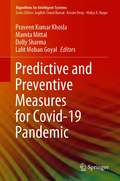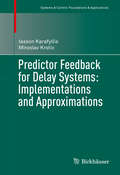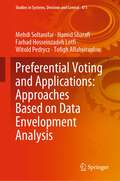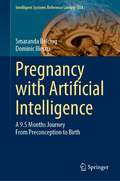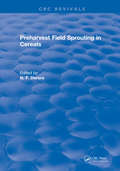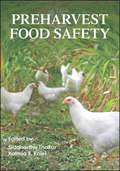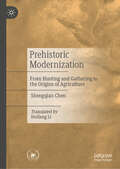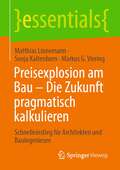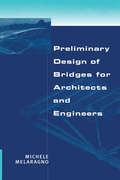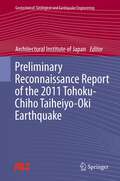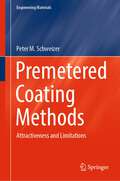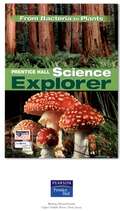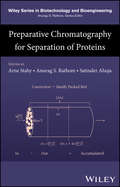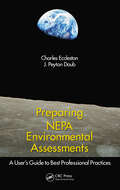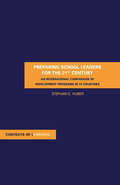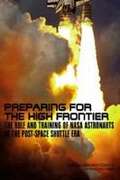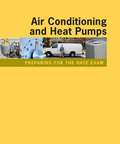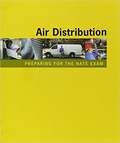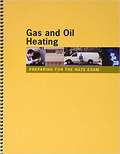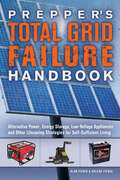- Table View
- List View
Predictive and Preventive Measures for Covid-19 Pandemic (Algorithms for Intelligent Systems)
by Mamta Mittal Lalit Mohan Goyal Praveen Kumar Khosla Dolly SharmaThis book explores the inputs with regard to individuals and companies who have developed technologies and innovative solutions, bioinformatics, datasets, apps for diagnosis, etc., that can be leveraged for strengthening the fight against coronavirus. It focuses on technology solutions to stop Covid-19 outbreak and mitigate the risk. The book contains innovative ideas from active researchers who are presently working to find solutions, and they give insights to other researchers to explore the innovative methods and predictive modeling techniques. The novel applications and techniques of established technologies like artificial intelligence (AI), Internet of things (IoT), big data, computer vision and machine learning are discussed to fight the spread of this disease, Covid-19. This pandemic has triggered an unprecedented demand for digital health technology solutions and unleashing information technology to win over this pandemic.
Predictor Feedback for Delay Systems: Implementations and Approximations
by Iasson Karafyllis Miroslav KrsticThis monograph bridges the gap between the nonlinear predictor as a concept and as a practical tool, presenting a complete theory of the application of predictor feedback to time-invariant, uncertain systems with constant input delays and/or measurement delays. It supplies several methods for generating the necessary real-time solutions to the systems' nonlinear differential equations, which the authors refer to as approximate predictors. Predictor feedback for linear time-invariant (LTI) systems is presented in Part I to provide a solid foundation on the necessary concepts, as LTI systems pose fewer technical difficulties than nonlinear systems. Part II extends all of the concepts to nonlinear time-invariant systems. Finally, Part III explores extensions of predictor feedback to systems described by integral delay equations and to discrete-time systems. The book's core is the design of control and observer algorithms with which global stabilization, guaranteed in the previous literature with idealized (but non-implementable) predictors, is preserved with approximate predictors developed in the book. An applications-driven engineer will find a large number of explicit formulae, which are given throughout the book to assist in the application of the theory to a variety of control problems. A mathematician will find sophisticated new proof techniques, which are developed for the purpose of providing global stability guarantees for the nonlinear infinite-dimensional delay system under feedback laws employing practically implementable approximate predictors. Researchers working on global stabilization problems for time-delay systems will find this monograph to be a helpful summary of the state of the art, while graduate students in the broad field of systems and control will advance their skills in nonlinear control design and the analysis of nonlinear delay systems.
Preferential Voting and Applications: Approaches Based on Data Envelopment Analysis (Studies in Systems, Decision and Control #471)
by Witold Pedrycz Tofigh Allahviranloo Farhad Hosseinzadeh Lotfi Mehdi Soltanifar Hamid SharafiThis book presents the theory and application of the models presented in this regard and establishes a meaningful relationship between data envelopment analysis and multi-attribute decision making. The issue of "choice" using the aggregation of voters' votes is one of the most important group decision-making issues that are always considered by decision makers in electoral systems. Voting is a method of group decision making in a democratic society that expresses the will of the majority. Voting is perhaps the simplest way to gather the opinions of experts, and this ease of application has made it a multi-attribute decision-making method in group decisions. Preferential voting is a type of voting that may refer to electoral systems or groups of the electoral system. In preferential voting, voters vote for multiple candidates, and how the candidates are arranged on the ballot is important. Researchers have made many efforts to provide models of voter aggregation, and one of the best results of these efforts is the aggregation of votes based on the policy of data envelopment analysis. Thus, in group decisions, the opinions of experts are obtained in a simple structure and consolidated in an interactive and logical structure, and the results can be a powerful tool for decision support.This book provides a complete set of voting models based on data envelopment analysis and expressing its various applications in industry and society. However, most decision-making methods do not use the opinions of experts or reduce the motivation of experts to participate in complex interactions and time, while voting methods do not have this shortcoming.This book is suitable for graduate students in the fields of industrial management, business management, industrial engineering, applied mathematics, and economics. It can also be a good source for researchers in decision science, decision support systems, data envelopment analysis, supply chain management, healthcare management, and others. The methods presented in this book can not only offer a comprehensive framework for solving the problems of these areas but also can inspire researchers to pursue new innovative hybrid methods.
Pregnancy with Artificial Intelligence: A 9.5 Months Journey From Preconception to Birth (Intelligent Systems Reference Library #234)
by Smaranda Belciug Dominic IliescuThis book aims to provide a refreshing, friendly and exciting manner artificial intelligence (AI) theoretical concepts and practical methods applied in obstetrics and gynaecology. The book follows the nine and a half months journey from preconception till birth alongside with AI. It discusses topics such as the poignant role of AI in improving the change of women getting pregnant; AI methods for detecting congenital anomalies in first and second trimester foetal sonography; how AI aids physicians in determining what type of birth should be deployed (vaginal versus caesarean); how AI can predict pre-eclampsia, preterm birth, mortality, birth weight, miscarriage, postpartum depression, etc. Additionally, it provides information on AI used for perinatal depression, for the evaluation of the relationship between pollutants and pregnancy outcome and even how AI tools can improve physician training in labour and delivery. The book is designed for bioinformaticians, obstetric and gynaecology researchers and physicians, and all those who wish to learn how to explore, analyse, find novel potential solutions for the challenging domains: obstetrics and gynaecology. Likewise, this book will be useful for application engineers who wish to use AI paradigms in areas such as engineering and science too.
Preharvest Field sprouting in Cereals
by N.F. DereraThis book summarizes the research done on preharvest sprouting during recent years. Naturally, whenever needed, earlier findings are also considered. Both publishers and the authors hope that his publication will provide researchers and students with a convenient source of up-to-date information in this expanding field.
Preharvest Food Safety (ASM Books)
by Siddhartha Thakur Kalmia KnielAn overview of farm-to-fork safety in the preharvest realm Foodborne outbreaks continue to take lives and harm economies, making controlling the entry of pathogens into the food supply a priority. Preharvest factors have been the cause of numerous outbreaks, including Listeria in melons, Salmonella associated with tomatoes, and Shiga toxin-producing E.coli in beef products, yet most traditional control measures and regulations occur at the postharvest stage. Preharvest Food Safety covers a broad swath of knowledge surrounding topics of safety at the preharvest and harvest stages, focusing on problems for specific food sources and food pathogens, as well as new tools and potential solutions. Led by editors Siddhartha Thakur and Kalmia Kniel, a team of expert authors provides insights into critical themes surrounding preharvest food safety, including Challenges specific to meat, seafood, dairy, egg, produce, grain, and nut production Established and emerging foodborne and agriculture-related pathogens Influences of external factors such as climate change and the growing local-foods trend Regulatory issues from both US and EU perspectives Use of pre- and probiotics, molecular tools, mathematical modeling, and one health approaches Intended to encourage the scientific community and food industry stakeholders to advance their knowledge of the developments and challenges associated with preharvest food safety, this book addresses the current state of the field and provides a diverse array of chapters focused on a variety of food commodities and microbiological hazards.
Prehistoric Modernization: From Hunting and Gathering to the Origins of Agriculture
by Shengqian ChenThis book explores the origins of agriculture in China, and the transformation from hunter-gatherer to agriculture producer. Therefore, it reveals the ancient genes of China as an agricultural country and digs into questions like what turning events occurred during the transformative period from hunting-gathering to agricultural production and why the development of agriculture is rapid in some regions while largely delayed in others. This book also introduces various definitions and theoretical methods on the study of agriculture’s origin. It represents the transforming era by simulating prehistoric hunter-gatherer’s survival strategies with data collected from modern weather station. The author also tries to answer questions on the origins of agriculture production in China with comprehensive archeology evidences.
Preisexplosion am Bau – Die Zukunft pragmatisch kalkulieren: Schnelleinstieg für Architekten und Bauingenieure (essentials)
by Markus G. Viering Matthias Linnemann Sonja KaltenbornDie Bauwelt sieht sich infolge der noch anhaltenden Corona-Pandemie sowie des Ukraine-Krieges mit einer Vielzahl an baubetrieblichen und rechtlichen Fragestellungen konfrontiert: beginnend bei der Frage zur Risikoverteilung bzgl. gestiegener Material- und Beschaffungspreise sowie dem Umgang mit Beschaffungsengpässen, über die Anspruchsgrundlagen zur Übernahme von Preissteigerungen, bis zur Betrachtung der Termini Höhere Gewalt sowie Wegfall der Geschäftsgrundlage. Dieses essential gibt Orientierung in einer undurchsichtigen Situation und beleuchtet dabei die Kernfragen, die in der Bauwelt diskutiert werden. Das primäre Ziel ist die Aufrechterhaltung des laufenden Baubetriebs durch einen partnerschaftlichen Umgang der Vertragsparteien sowie dem korrekten Umgang mit den baubetrieblich und rechtlich kritischen Thematiken, bspw. der Preisgleitklausel. Zudem wird ein pragmatischer Lösungsansatz vorgestellt, welcher nach baubetrieblich-sachverständigen Aspekten zur Wiederherstellung des Risikogleichgewichts zwischen den Vertragsparteien beiträgt.
Preliminary Design of Bridges for Architects and Engineers
by Michele MelaragnoFocusing on the conceptual and preliminary stages in bridge design, this book addresses the new conceptual criteria employed when evaluating project proposals, considering elements from architectural aspects and structural aesthetics to environmental compatibility.;College or university bookstores may order five or more copies at a special student price. Price is available on request.
Preliminary Reconnaissance Report of the 2011 Tohoku-Chiho Taiheiyo-Oki Earthquake
by Architectural Institute of JapanDevastating damage in the Tohoku region of Japan occurred during and after the earthquake off the Pacific coast of Tohoku earthquake on March 11, 2011. The AIJ (Architectural Institute of Japan) dispatched reconnaissance teams into the field to obtain basic facts on the damage to buildings due to the massive ground motions and resultant tsunami. Their mission included collecting information on the characteristics of the earthquake itself and the observed major ground motions and tsunamis throughout the area. For the structural damage investigation, buildings are classified by their type of construction, namely, steel buildings, reinforced concrete buildings, wooden houses, etc. along with descriptions of special features for each category of building type. The report summarizes damage associated with ground failures including landslide and liquefaction as well as non-structural damages such as to equipment and facilities, partitioning walls and ceilings, and functional failures in skyscrapers. Also brief description of the Japanese Seismic Design Code will be provided in the Appendix. A proposed scheme of anti-tsunami design for buildings is also included.
Premetered Coating Methods: Attractiveness and Limitations (Engineering Materials)
by Peter M. SchweizerThis book compares premetered methods to self-metered processes and addresses general properties of premetered methods. It presents specific properties of slot, slide, and curtain coating. The book is divided in three parts: Part I compares premetered methods to self-metered processes. It explains the term “premetered,” which is an expression of the law of mass conservation, and discusses the physical fluid properties that are relevant for premetered processes. Furthermore, it presents in detail the various basic flow fields that make up premetered coating methods. Lastly, it introduces the concepts of wall shear stress, residence time, and hydrodynamic assist to dynamic wetting. Part II addresses general properties of premetered methods, such as the fluid conditioning and delivery systems, the nominal film thickness, and the film thickness uniformity, both in machine and cross-web directions (die design). It lists the attractive features of simultaneous multilayer applications, including an explanation of how mixing of adjacent layers can be prevented. This section concludes by revisiting examples of economic considerations. Part III presents specific properties of slot, slide, and curtain coating. It examines various topics, such as coating equipment and coating configurations, coating modes, details of the various flow fields, operating window and process limitations, and process optimization.
Prentice Hall Science Explorer: From Bacteria to Plants
by Michael J. Padilla Ioannis Miaoulis Martha CyrPresents an introduction to the classification of organisms, including bacteria, fungi, and plants.
Prentice Hall Science Explorer: The Nature of Science and Technology
by Michael J. Padilla Ioannis Miaoulis Martha Cyr Beth Miaoulis Andrew Carl KempThis science textbook promotes science inquiry and meets the National Science Education Standards.
Preparation, Characterisation and Reactivity of Low Oxidation State d-Block Metal Complexes Stabilised by Extremely Bulky Amide Ligands
by Jamie HicksThis thesis describes the synthesis and characterization of numerous metal-metal bonded complexes that are stabilized by extremely bulky amide ligands. It provides a comprehensive overview of the field, including discussions on groundbreaking complexes and reactions, before presenting in detail, exciting new findings from the PhD studies. The thesis appeals to researchers, professors and chemistry undergraduates with an interest in inorganic and/or organometallic chemistry.
Preparative Chromatography for Separation of Proteins
by Satinder Ahuja Anurag S. Rathore Arne StabyPreparative Chromatography for Separation of Proteins addresses a wide range of modeling, techniques, strategies, and case studies of industrial separation of proteins and peptides.• Covers broad aspects of preparative chromatography with a unique combination of academic and industrial perspectives• Presents Combines modeling with compliantce useing of Quality-by-Design (QbD) approaches including modeling• Features a variety of chromatographic case studies not readily accessible to the general public• Represents an essential reference resource for academic, industrial, and pharmaceutical researchers
Preparing Mathematics and Science Teachers for Diverse Classrooms: Promising Strategies for Transformative Pedagogy
by Alberto J. Rodriguez Richard S. KitchenThis book provides a theoretical basis and practical strategies to counter resistance to learning to teach for diversity (in culturally and gender-inclusive ways), and resistance to teaching for understanding (using student-centered and inquiry-based pedagogical approaches). Teacher educators from across the United States present rich narratives of their experiences in helping prospective and practicing teachers learn to teach for diversity and for understanding in a variety of mathematics and science contexts. Mathematics and science education has been slow to respond to issues of diversity and equity. Preparing Mathematics and Science Teachers for Diverse Classrooms: Promising Strategies for Transformative Pedagogy helps to begin a network for support and collaboration among teacher educators in science and mathematics who work for multicultural education and equity. A unique and much-needed contribution, this book is an essential resource for teacher educators, K-12 teachers who work as student teacher supervisors and cooperating teachers, and graduate students in mathematics and science education, and a compelling text for science and mathematics methods courses.
Preparing NEPA Environmental Assessments: A User's Guide to Best Professional Practices
by J. Peyton Doub Charles EcclestonThe National Environmental Policy Act (NEPA) regulations provide surprisingly little direction for preparing environmental assessments (EA). This book addresses this problem by providing a step-by-step guide for preparing EAs. Bridging the regulatory gap, it draws on information scattered throughout NEPA regulations and guidance documents, as well as best professional practices (BPP) and case law. The book progresses from the fundamentals to successfully more advanced topics, making it suitable for beginners, students, and experienced practitioners alike. It provides an indispensable guide for managing, analyzing, and writing legally defensible EAs.
Preparing School Leaders for the 21st Century (Contexts of Learning)
by Stephan Gerhard HuberThe quality and success of schools depend upon school leadership. Increasingly, in many countries worldwide, this belief has led to designing and implementing appropriate training and development programs for educational leaders. In an international comparative research project, current school leader training and development programs in fiftee
Preparing for Peak Oil in South Africa
by Jeremy J. WakefordOil is the lifeblood of modern industrial economies. Petroleum powers virtually all motorized transport, which in turn enables most economic activities and provides mobility for citizens. But oil is a finite resource that is steadily depleting. In the past decade, the phenomenon of global peak oil - the fact that annual world oil production must at some point reach a maximum and then decline - has emerged as one of the twenty-first century's greatest challenges. South Africa imports over two-thirds of its petroleum fuels, and history has shown that oil price shocks generally translate into a weakening currency, rising consumer prices, increasing joblessness and a slow-down in economic activity. This book examines the implications of peak oil for socioeconomic welfare in South Africa and proposes a wide range of strategies and policies for mitigating and adapting to the likely impacts. It contains a wealth of data in tables and figures that illustrate South Africa's oil dependencies and vulnerabilities to oil shocks. The material is presented from a systems perspective and is organized in key thematic areas including energy, transport, agriculture, macro-economy and society. The study highlights the risks, uncertainties and difficult choices South Africa faces if it is to tackle its oil addiction, and thereby serves as an example for researchers, planners and policy-makers in the developing world who will sooner or later confront similar challenges. This case study brings a fresh southern perspective to an issue of global importance, and shows how the era of flattening and then declining global oil supplies may be a pivotal period in which either the project of industrialization progressively runs out of steam, or societies are able to undertake a proactive transition to a more sustainable future.
Preparing for the High Frontier
by Committee on Human Spaceflight Crew OperationsAs the National Aeronautics and Space Administration (NASA) retires the Space Shuttle and shifts involvement in International Space Station (ISS) operations, changes in the role and requirements of NASA's Astronaut Corps will take place. At the request of NASA, the National Research Council (NRC) addressed three main questions about these changes: what should be the role and size of Johnson Space Center's (JSC) Flight Crew Operations Directorate (FCOD); what will be the requirements of astronaut training facilities; and is the Astronaut Corps' fleet of training aircraft a cost-effective means of preparing astronauts for NASA's spaceflight program? This report presents an assessment of several issues driven by these questions. This report does not address explicitly the future of human spaceflight.
Preparing for the NATE Exam: Air Conditioning and Heat Pumps
by Refrigeration Service Engineers SocietyPreparing for the NATE Exam is a series of training manuals designed to give HVACR technicians and installers the tools they need to be successful in mastering the key concepts required to pass the NATE examinations. Each manual in the series is written in clear and concise language and illustrated with full color graphics that clarify important details.
Preparing for the NATE Exam: Air Distribution Manual
by Refrigeration Service Engineers SocietyPreparing for the NATE Exam is a series of training manuals designed to give HVACR technicians and installers the tools they need to be successful in mastering the key concepts required to pass the NATE examinations. Each manual in the series is written in clear and concise language and illustrated with full color graphics that clarify important details.
Preparing for the Nate Exam: Core Essentials
by Refrigeration Service Engineers SocietyPreparing for the NATE Exam is a series of training manuals designed to give HVACR technicians and installers the tools they need to be successful in mastering the key concepts required to pass the NATE examinations. Each manual in the series is written in clear and concise language and illustrated with full color graphics that clarify important details.
Preparing for the Nate Exam: Gas and Oil Heating
by Refrigeration Service Engineers SocietyPreparing for the NATE Exam is a series of training manuals designed to give HVACR technicians and installers the tools they need to be successful in mastering the key concepts required to pass the NATE examinations. Each manual in the series is written in clear and concise language and illustrated with full color graphics that clarify important details.
Prepper's Total Grid Failure Handbook: Alternative Power, Energy Storage, Low Voltage Appliances and Other Lifesaving Strategies for Self-Sufficient Living (Preppers Ser.)
by Arlene Fiebig Alan FiebigThe ultimate guide to creating, storing and utilizing lifesaving power in the most critical circumstancesBatteries don&’t last forever. To successfully survive a long-term disaster, you&’ll need self-reliant, renewable electricity. This book teaches you how to: CREATE YOUR OWN POWER• Choose cost-efficient solar panels• Incorporate a micro-hydro system• Harness the wind with turbinesMANAGE ENERGY STORAGE• Select durable battery banks• Rewire for energy efficiency• Control energy consumptionLIVE COMFORTABLY ON LESS• Install a high-efficiency refrigerator and LEDs• Use a human-powered washing machine• Charge laptops and cell phonesWritten in an approachable, easy-to-understand style, Prepper&’s Total Grid Failure Handbook provides everything you need to survive long-term without grid power.
